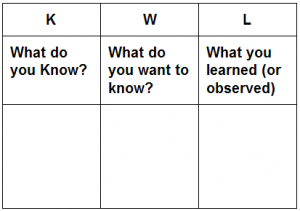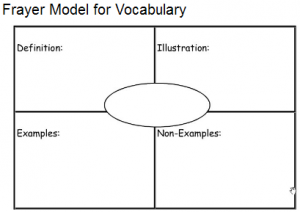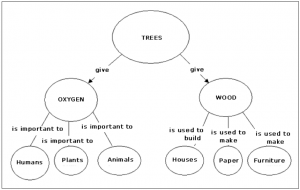Meeting the needs of diverse learners can be achieved by utilizing a variety of instructional strategies before, during and after each lesson. This article will offer you strategies that make a significant difference for students’ comprehension and retention of content. Based on Universal Design, Learning Theories and Literacy strategies, one of the key concepts begins with activating prior knowledge. Thinking back to language development and Piaget’s schemata, by activating prior knowledge, students become engaged in the content and also ignite prior knowledge on the subject. Activating prior knowledge builds a bridge between what a person knew about a subject and what they will be adding to that subject. By providing visual imagery, anchoring concepts, and providing advanced organizers, students will add to what they know. Here are some strategies below for activating prior knowledge.
Concept Maps
In-Class Modeling
 Begin by modeling concept maps in your class demonstrating key concepts and relationships between those concepts. Then you can create one with your students or have them create one in small groups.
Begin by modeling concept maps in your class demonstrating key concepts and relationships between those concepts. Then you can create one with your students or have them create one in small groups.
Out-of-Class Uses
Once you have modeled and practiced the strategy, you can assign students to create concept maps as pre-reading assignments for credit.
Assessment
Link your assignment to a concept map rubric for assessment and feedback.
K-W-L Chart
 One effect graphic organizer is a K-W-L: What do you KNOW?, What do you WANT to know? and What did you Learn are the phrases for the chart. This strategy works for activating prior knowledge and also hooking students on what they want to learn. The Learn section provides a great place for summaries. This strategy also gives you an indication on what concepts students might be lacking for the course and suggest areas you may need to scaffold or pre-load.
One effect graphic organizer is a K-W-L: What do you KNOW?, What do you WANT to know? and What did you Learn are the phrases for the chart. This strategy works for activating prior knowledge and also hooking students on what they want to learn. The Learn section provides a great place for summaries. This strategy also gives you an indication on what concepts students might be lacking for the course and suggest areas you may need to scaffold or pre-load.
Prerequisite Knowledge and Vocabulary
 Develop prerequisite concepts and vocabulary prior to beginning your lesson. You may want to assign vocabulary in particular as an out-of-class skill development. Remember, without adequate vocabulary background knowledge, it is like you are pouring water through a sieve. Students may use charts like the Frayer Model or create their own index cards or an electronic version to learn and practice.
Develop prerequisite concepts and vocabulary prior to beginning your lesson. You may want to assign vocabulary in particular as an out-of-class skill development. Remember, without adequate vocabulary background knowledge, it is like you are pouring water through a sieve. Students may use charts like the Frayer Model or create their own index cards or an electronic version to learn and practice.

Concept maps are also useful for creating connections and uploading prerequisite information students need to understand. When faculty members create and model with a concept map, students are able to see relationships and visually organize and store information. Visual organizers prove powerful for cementing information into short and long-term memory. As in the example above, students may have known trees are a source of wood, but as they progress in their knowledge, they can add to their schema that trees also produce oxygen and in further, how live trees produce oxygen that is important for humans, plants and animals. Concept maps can show many relationships; hierarchy, progression and comparison and contrast to name a few. The key point is that concept maps are a visual tool to make meaning for students while building their knowledge base.
Creating a Focus or Purpose for Learning
Framing a lesson by asking Key Questions is one way to focus learning and create an anticipatory set. Beginning your session with Key Questions alerts your students to what they will be learning and the information they are accountable for learning that day. Have Key Questions posted when students enter the room and highlight them as you begin class. Key Questions can also fit a text and suggest the type of focus and thinking a student will need to learn the material. A few examples are listed below.
Key Questions: Text Frame or Concepts & General Types of Questions
Cause/Effect:
- Why or how something works?
- Why or how something happens?
- Why things happen in science?
Compare/Contrast:
- How things are alike/different.
- How things are positive/negative.
- What choices or options are possible?
Problem/Solution:
- What is wrong and how it can be taken care of?
- What needs to be improved, changed, fixed, or remedied?
- Who is confronting problems in history?
Key questions can also be used to frame reading assignments prior to class. By using a two-column or three-column note-taking approach, students can focus on the Key Question and take notes prior to class. Then students will be prepared to share information in class. Students can also use a three-column approach to add notes from lectures and discussions. The process of pre-thinking, note-taking, listening and discussing also aids retention by repetition and multiple approaches to inputting information into short and long term memory.

In the next article, look for instructional strategies to increase comprehension during class sessions. In the meantime, please contact Kay Harris, Curriculum and Instructional Designer, at 5-1957 or fharris@nmc.edu for questions or to collaborate.

